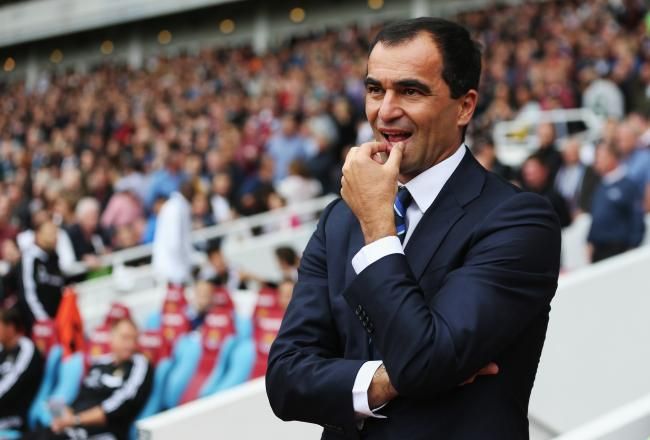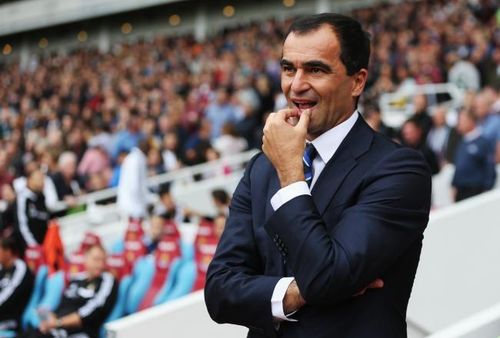
In-depth analysis of Everton’s tactical changes under Roberto Martinez

When Roberto Martínez took charge at Everton, following the 11 year tenure of David Moyes, the Spaniard’s appointment was met with sniggers of disbelief from rival fans.
The stability, togetherness and unity that made Everton such a well-run club, constructed and moulded by the former Preston North End manager, was sure to dwindle. The consistent top-half finishes throughout the last seven years would be a thing of the past. And David Moyes’ ability to construct a spirited side on a shoestring, while remaining competitive with the best that the Premier League had to offer, was over.
Everton’s inspirational leader had departed, and their adversaries were quick to point out the potential downfalls of his successor.
Bill Kenwright appointed Roberto Martínez; a manager who had steered Wigan Athletic into the dark abyss of relegation, clutching a 2013 FA Cup winner’s medal as he descended. A man whose courageous ideologies, combined with a defence that boasted more holes than a sieve, failed to deliver the desired results in a constant battle against the dreaded drop. David Moyes’ spell as Everton manager may have lacked silverware, and his record versus the top four was hardly impressive, however his methods were greatly admired and appreciated by a vast majority within football.
Throughout the mockery and scepticism over his ability to manage at a higher level, Martínez has remained humble. A soft-spoken, honest and eloquent man. But more importantly, an ambitious man who can recover from setbacks, remaining strong in his tactical beliefs and philosophies. A driven purpose that seemingly never wavers.
“THROUGHOUT THE MOCKERY AND SCEPTICISM OVER HIS ABILITY TO MANAGE AT A HIGHER LEVEL, MARTÍNEZ HAS REMAINED HUMBLE.”
Eleven games into the 2013-14 campaign and Everton are comfortably within the top half of the table. Not much has changed then. Or has it?
I shall attempt to shed light on the various changes in Everton’s style and philosophy since the change of management. An analytical comparison based on Squawka’s statistics from the first 11 Premier League games of the 2012-13 and 2013-14 season.
(All statistics correct at the time of writing.)
Performance Score
Statistical Breakdown
The opening 11 games of the 2012-13 campaign saw David Moyes’ Everton achieve a Squawka Performance Score of 3,595.
Contrastingly, Everton have achieved a Performance Score of 3,241 under the guidance of Roberto Martínez.
 Everton’s Performance Score this season.
Everton’s Performance Score this season.
Breaking down the total Performance Score into three separate categories, reveals the following:
- This season, Everton have a possession score of 453. Last season, they totalled 765.
- This season, Everton have a defence score of 1,481. Last season, they totalled 673.
- This season, Everton have an attack score of 1,307. Last season, they totalled 2,156.
Analysis
The most obvious change, having analysed the graph, is that Everton’s defensive score has not dropped below zero this season. Whereas during the same timescale under David Moyes, the defensive score dropped below zero four times, due in part to defensive errors (more on that later).
Only two teams have conceded fewer than the Toffees throughout the current league campaign, which is reflected by their impressive defence score.
Goals Conceded
Statistical Breakdown
Last season, Everton conceded 14 goals after the first 11 games. Ten inside the area, four outside area.
 Comparison of goals conceded after 11 matches.
Comparison of goals conceded after 11 matches.
This season, Everton have conceded 10 goals in 11 games. Eight inside the area, two outside.
Analysis
So often Wigan Athletic’s downfall, Roberto Martínez has inherited a solid and reliable defence, centred on the experienced pairing of Sylvain Distin and Phil Jagielka. Energetic Séamus Coleman and the ever-impressive Leighton Baines, complete the back four.
 Distin and Jagielka are two of the most active defenders this season.
Distin and Jagielka are two of the most active defenders this season.
It’s no secret that Wigan conceded the greatest number of goals (73) last season – along with Reading – slumping to relegation to The Championship. However, in Distin and Jagielka (see above), Everton’s new manager has acquired two of the most active, yet consistent defenders in the league.
“IN DISTIN AND JAGIELKA, EVERTON’S NEW MANAGER HAS ACQUIRED TWO OF THE MOST ACTIVE, YET CONSISTENT DEFENDERS IN THE LEAGUE”
Combined with the Spaniard’s philosophy of keep-ball, Everton look far more solid at the back this time around.
Goals Scored
Statistical Breakdown
At this stage last season, Everton had scored 21 goals – the second highest total in the league behind Manchester United (29). Their goals were dispersed between left foot (six), right foot (eight) and head (six), with 19 arriving from inside the area and two from outside.
 Comparison of goals scored after 11 matches.
Comparison of goals scored after 11 matches.
Under Martínez, Everton have scored 14 goals – the seventh highest total in the league. They’ve scored five goals via the right boot, seven via the left and only two goals from headers. Ten goals have arrived inside the area, while four have been scored outside of the 18-yard box.
Analysis
Comparing last season’s goal scorers to this season, Romelu Lukaku leads the way for the Toffees with five. Whereas Everton could rely on the free-scoring talents of Nikica Jelavi? (5) and Marouane Fellaini (6) under David Moyes.
Roberto Martínez has had to deal with an uninspiring Croatian and a missing Belgian, who joined the red half of Manchester this summer. Where would Everton’s goals come from if their 20-year-old loan signing picks up an injury?